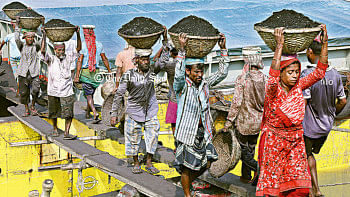FIGHTING THE EPIDEMIC

Every summer, outbreak of waterborne diseases in Dhaka takes an epidemic form. What is the solution?
When Faria Akhter, the 1.5 year old daughter of Rizia Khatun and rickshaw puller Abdur Rahim, started to vomit and was dehydrated continuously, her parents panicked. It was around 3 am and the couple had no idea what to do in this situation. At around 5 am they managed to reach ICDDR,B popularly known as Cholera Hospital, from the Kafrul slum area. Despite the doctor's assurance that her daughter will be out of danger very soon after receiving a re-hydrating saline injection, Rizia had many reasons to worry. "I had to admit her to the same hospital once before, because of the same reasons," says Rizia. "She was only six months old at the time. She has become so weak and her skin has turned blue!"
Faria's case is not very uncommon. In fact, many in the country including adults get sick because of the dirty water that they drink. Every summer, diarrhoeal disease takes an epidemic form in our country especially in the densely populated cities such as Dhaka. According to a research, around 2 million children die of waterborne diseases in Bangladesh every year and Diarrhoea alone causes 90 percent of these deaths.
"But there is no alternative water source in our slum," adds Rizia. "If this continues, my daughter may not survive such an attack, again.”
The situation is quite common in many densely populated parts especially in the slum areas of Dhaka city. Last week, a 2-year-old boy died on his way to the hospital. Before taking him to the hospital, the boy was treated by a local quack. The wrong treatment proved ultimately fatal for the boy.

Dr NH Alam, senior scientist at ICDDR,B of the clinical sciences division says that watery diarrhoea is the most common form of waterborne diseases. "After the brief spell of winter when temperature starts to rise, the weather turns humid. This hot and humid environment acts as a favourable condition for the reproduction of diarrhoeal bacteria," says Dr Alam. "As a result, during summer, food gets contaminated easily and scarcity of freshwater also makes water more likely to be contaminated. Consumption of contaminated food and water is the most common cause of diarrhoeal diseases.”
However, authorities do not make much effort toward solving this issue. Scarcity of safe drinking water is severe in many parts of Dhaka. Abidur Rahman, a resident of Wari of Old Dhaka says that at least for six hours a day his family gets dirty coloured water from the tap. "In some cases, the smell of chemicals in the water is so intense that we are very afraid of using it," says Rahman. "It not only causes diarrhoea but it is also harmful to our skin and increases hair-fall.”
Consumption of contaminated food is also a major cause of the diarrhoeal epidemic. In Dhaka, peddlers sell fruits, coloured juice and stale food in their open shops and carts. Bottled cold water collected from unknown sources is sold like hot-cakes. On a hot day of 40 degree celsius, pedestrians are compelled to consume such food and drinks to quench their hunger and thirst. Law enforcers or the city health officials seem to have no concern in regulating these unhygienic sources of food and drink.
So, will these diseases rule the city and claim millions of lives every year? "Vaccines have been developed for some of the versions of diarrhoea and other waterborne diseases like typhoid," says Dr NH Alam. "But it has been found that efficacy of these vaccines get reduced after six months or a year. Since we cannot ensure safe drinking water in the city, maintaining hygiene is the only way to prevent the epidemic. Practices like washing hands after using the latrine, consuming freshly cooked food and boiled water can reduce the rate of infection considerably.”
Ensuring safe drinking water for the city dwellers should be the first concern of the newly elected mayors. If the situation continues, existence of densely populated cities like Dhaka will be under threat.


 For all latest news, follow The Daily Star's Google News channel.
For all latest news, follow The Daily Star's Google News channel. 



Comments